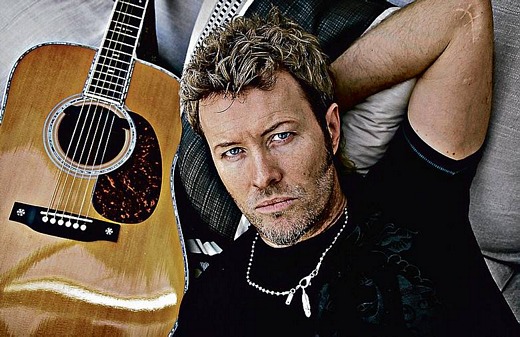Article: The Dead Parents Club

Picture by Rolf M. Aagaard for A-Magasinet
These people have something basic in common: They are creatively innovative. And they lost their mother or father as children.
[The text above is printed across a 2-page spread with pictures of Madonna, Magne Furuholmen, Anne Karin Elstad, Orlando Bloom, Edvard Munch, Paul McCartney, James Dean, Bono, 50 Cent, Ludwig van Beethoven, John Lennon and Charles Darwin. Other people mentioned later in the article include Bob Geldof, J. R. R. Tolkien, Hank von Helvete, Aldous Huxley, Jean-Paul Sartre, Jussi Bjørling, Orson Welles, Johann Strauss, Ludvig Holberg and James Hetfield.]
On 1st December 1963 in Pontiac, Michigan, USA, she loses her mother. Little Nonni – that’s what the Ciccone family calls her – is five years old, her mother is thirty. In a conversation with the British TV-host Michael Parkinson 42 years later, long after packing her bags and leaving for New York to become a dancer, she says:
“My mother’s death had a strong influence on me. I decided to form “The Dead Mothers Club”, but I didn’t know anyone else whose mother had died. So I was the only member of my club. I felt isolated and lonely as a child, but I don’t feel sorry for myself. It was good character building.”
Little Nonni is named after her mother:
Madonna.
The disaster. On May 1st 1969, a small two-engine airplane with the six musicians in Bent Sølve’s Orchestra takes off from Fornebu.
Among them is Kåre Furuholmen. The 29-year-old has his trumpet in a case together with handwritten sheets of music, including the jazz-standard “Dance for Daddy”.
They are on their way to do a gig in Gothenburg, but the weather is bad near the Swedish city. The plane is asked to return.
It isn’t until 1982 that Magne Furuholmen is going to meet an eye witness who can provide him with this last remnant of his father’s history – a father he doesn’t remember much of. It’s the day he meets the band’s new vocalist.
For fate has it that on the first day of May in 1969, nine year old Morten is sitting in the Harket family’s Toyota on the way home from Sørlandet. At Drammen, his father spots an airplane and remarks that it appears to be having problems. It goes into a spin and then crashes into the ground, with too little fuel in the tank and engine-failure on one side. The whole band and the pilot all die.
That same day, Magne awakes because his grandfather, with whom he’s spent the night, is lying in bed crying.
“He was totally devastated, and I had to comfort him. Getting the news that one father figure was gone, while another was breaking apart, is what I remember as the most traumatic. Responsibility was handed over to me from that point on”, Magne Furuholmen says.
After his father’s death, the instruments and an empty space remains. Shortly afterwards Magne starts playing music.
The keyboardist in a-ha, the composer, songwriter and artist is now 45 years old. He says that he has thought a lot about the connection between his father’s death and his own work.
“I think that an emotional blow like this one can be really good for your creativity. That some of the greatest gifts you get in life are the ones that at first sight appear to be disasters. Gifts in disaster-wrapping. I know it’s dangerous to say things like this, but my intention of saying it is to give young people who have experienced the same situation a feeling of that no matter how dramatic and serious things are, there may be something really rewarding at the other end, if you just manage to go through it. The gift my father gave to me was the freedom of not having to live in his shadow”, he says.
(…)
Died at a funeral. September 10th, 1974. 14 year old Paul David Hewson is at his grandfather’s funeral. In the middle of the ceremony, his mother Iris suffers a cerebral hemorrhage and dies.
Millions of people will later be hearing Bono in U2 singing about his mother. Like in the song “Mofo”:
Mother, am I still your son?
You know I’ve waited for so long
to hear you say so.
Mother, you left and made me someone.
Now I’m still a child, no one tells me no.
Two mothers. In Liverpool in the 1950s, another Paul loses his mother. Mary Patricia dies from breast cancer. He is 14 years old, and shortly afterwards he asks his father to get him a guitar. Somewhere else in the same city, Julia teaches her son John to play the banjo. She introduces him to the music of Elvis. But then, on July 15th, 1958, his mother is run over by a drunk policeman. These mutual events connect the boys closely together. They start a band. They colour the whole 1960s with their songs. It’s his own mother that Paul McCartney is singing about in “Let it Be”.
I wake up to the sound of music,
mother Mary comes to me,
speaking words of wisdom, let it be.
And John Lennon on “The White Album”:
Half of what I say is meaningless
But I say it just to reach you
Julia
(…)
Magne Furuholmen explains how he can consider the loss of his father as a gift.
“It’s not about seeing the positive in the negative, it’s about getting a possibility to acknowledge something. Or to say it in a more prosaic way: My basic attitude in life is that breaking my arm in three separate snowboard accidents makes me a better guitarist, because it makes it harder for me to be good at certain techniques. It forces me to be creative in a way that I hadn’t been able to otherwise”, he says.
During the period from 1989 to 1994, Magne Furuholmen carries with him the trumpet case that his father had on the plane. It works as a kind of talisman on his many journeys. When he gets his big breakthrough as a visual artist with the exhibition “Kutt” at the Henie-Onstad Art Center in 1995, his father’s handwritten sheets of music that were in the case have been the inspiration.
“During self-critical moments I have almost felt my work as being mental grave robbery. I have taken specific items from the trumpet case, for example, and turned them into works of art. “Dancy for Daddy” is now not just a sad memory, it’s a painting that exists where my father doesn’t exist. I have tried to seize, repossess, my own life story. At the same time I’m seeking the acknowledgement that I never got from my father by sharing my work with an abstract recipient”, Furuholmen says.
(…)
Other traumas. Can increased creativity also be connected to other kinds of life crisis besides deaths?
Magne Furuholmen is convinced of this.
“Everyone has a need to define their life in their own mind, but for me it became so crystal clear. If you experience other, less definite traumas, that need may be less apparent, but it’s still possible that they can make you grow”, he says.
(…)
“Raknekis”. In the a-ha biography “The Swing Of Things”, Magne Furuholmen describes himself as a “raknekis” [emotional guy]. In 1999 he collapsed mentally and physically after conflicts in a-ha, a lot of alcohol and an almost suicidal work schedule.
“I have a bit jokingly diagnosed myself as having a touch of bipolar disorder. The fact that I get these emotional highs and later feels really down. That ends in tragedy for many people. For me, the down periods is where the creativity kicks in. They are enormously initiating. They give me the opportunity of transforming the sorrows and losses in life into something I can celebrate. It doesn’t feel very good when I’m on my way down, but when I’m down there I have an arsenal of things that keep me from blacking out completely. The possibility of translating melancholy into action keeps you functioning more or less OK. That way, the depressions don’t become so dramatic for me. Creativity is a way of taking responsibility of your own loss. One of the ways”, he says.
Excerpts from an article in A-magasinet, 9th May 2008
Translation by Jakob

 For the latest updates,
For the latest updates,


